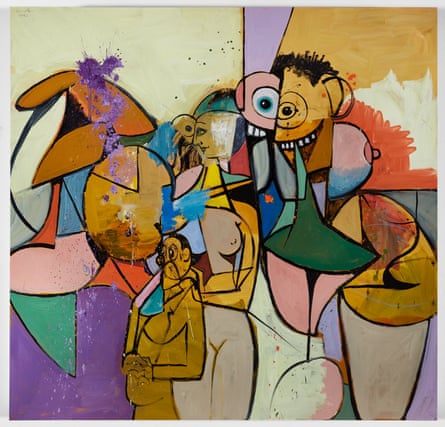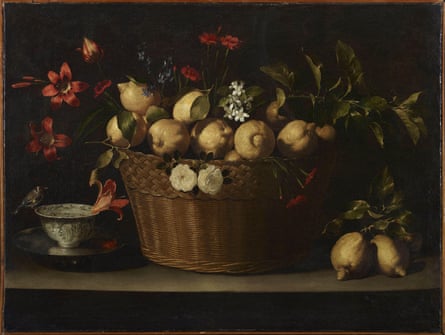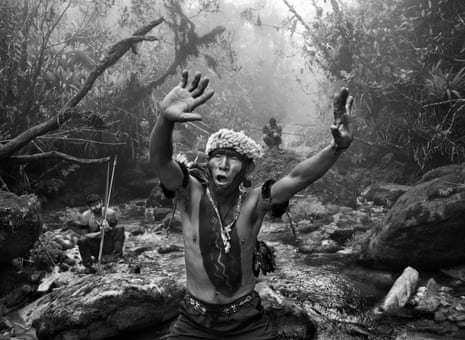Exhibition of the week
Salgado: Amazônia
The great photographer Sebastião Salgado unveils his most moving project yet – a rich and startling journey into the rainforest he calls “a paradise on Earth”.
Science Museum, London, 13 October to March 2022.
Also showing
Anicka Yi
A multisensory experience is promised by the Tate’s latest attempt to fill the Turbine Hall with the perfume of the new.
Tate Modern Turbine Hall, 12 October to 16 January.
Frieze London and Frieze Masters
A sure sign of the art world getting back to normal is the return of this vast art fair as a physical reality, filling two futuristic tents as in the halcyon pre-pandemic days.
Regent’s Park, London, 13-17 October.
Dislocations: Territories, Landscapes and Other Spaces
Charlotte Prodger, Carol Rhodes and Andy Goldsworthy are among the artists taking a fresh look at landscape in this survey of contemporary visions of nature.
Hunterian Art Gallery, Glasgow, until 5 December.

George Condo: Ideals of the Unfound Truth
Picasso collapses into the gutter in Condo’s depraved and decayed take on cubist painting.
Hauser and Wirth, London, 13 October to 23 December.
Image of the week

The first public statue of a black woman by a black female UK artist
There were tears of joy and pride as the first statue of a black woman created by a black woman for a public space in the UK was unveiled in a sunlit garden at the University of Bristol on 4 October. Three generations of of Henrietta Lacks’s family travelled from the US for the unveiling of the bronze statue of her, sculpted by the Bristol artist and campaigner Helen Wilson-Roe.
What we learned
Christo’s Abu Dhabi Mastaba will be the world’s largest artwork
Anish Kapoor explained his Freudian fascination with vaginas
Shilpa Gupta’s new show is a rousing salute to free speech
Anicka Yi may spring an olfactory surprise on Tate’s Turbine Hall
Pandora papers shed light on the murky world of antiquities dealing
The UK’s oldest synagogue has won the first stage of its battle against plans for skyscrapers nearby
Van Gogh’s sketches for The Potato Eaters are on show for the first time
Poussin was not the sombre prude some imagined
Alvaro Barrington’s work captures a modern storm …
… but Hervé Télémaque’s seems out of date
Jill Freedman went on the beat with the NYPD …
… while Martin Parr went off to the tennis
Kikuji Kawada’s haunting Hiroshima photobook is being reproduced
Kashmir’s papier-mache artists fear their art is in decline
Pablo Bronstein’s vision of hell is a place of architectural excess
NFTs have pushed contemporary art sales to a record high
Film-maker Paul Sng explored Britishness
Armagh City, Bradford and Stirling are among places for the next UK city of culture
Designers proposed alternative artwork for Nirvana’s Nevermind
Mark Rothko’s son revealed how the artist found light in his darkest days
Swedish architect Sigurd Lewerentz achieved beauty in solemnity
Torkwase Dyson is fascinated by water
Cricket was revealed as an unlikely art form
Jim Naughton creates wildlife fantasias
Ted Lau peeked behind North Korea’s curtain …
… while Raúl Cañibano has photographed Cuba for 30 years
Australian aerial photographer Brad Walls seeks poise amid the pandemic
A mysterious 15th-century tapestry has got a clean start …
… and ancient Khmer sculptures were returned to Cambodia
Clovis Salmon filmed Brixton ablaze …
… and a divisive housing block there was reassessed at 40
The Female in Focus awards celebrate women’s photography and spirit …
… while street photographer Helen Levitt receives long-overdue attention …
… and Tamara Dean is focusing on who she’d like to be
Michael von Graffenried’s best photograph captures a country in denial
Cumbria’s West Coast photo festival will unite young and established talent
Australian and Afghan artists are responding to the war in Afghanistan
Convicted murderer Donny Johnson found escape through art
Ballet dancer Colin Jones had a photojournalist’s eye
Edvard Munch’s Madonna once struck a different pose
New wave bands struck a fresh chord in poster art
The surf’s been up in Australia for a long time
The winners of the Royal Society of Biology photography competition were announced
A worthy Turner prize could push the public away
We remembered art critic Mel Gooding
Masterpiece of the week

Juan de Zurbarán: Still Life with Lemons in a Wicker Basket, c 1643-49
The citrus tang of life is glowingly preserved in this basket stuffed with bright, knobbly lemons. One is cut to reveal its interior. Sevillean artist Zurbarán – like his fellow southern Spanish painter Picasso centuries later – isn’t satisfied to show the surface of things but wants to expose their insides, too. To heighten the sensual presence of his roughly textured, sun-yellow fruits he sets them against an arrangement of flowers in darker, more nocturnal hues. He has a keen eye – but then he had a great teacher. Young Juan learned to paint from his father, the mystical artist Francisco de Zurbarán. He was still in his 20s when he created this powerful work. But his career was almost over. In 1649, he died along with half Seville’s population in an outbreak of plague.
National Gallery, London.
Don’t forget
To follow us on Twitter: @GdnArtandDesign.
Sign up to the Art Weekly newsletter
If you don’t already receive our regular roundup of art and design news via email, please sign up here.
Get in Touch
If you have any questions or comments about any of our newsletters please email newsletters@theguardian.com
